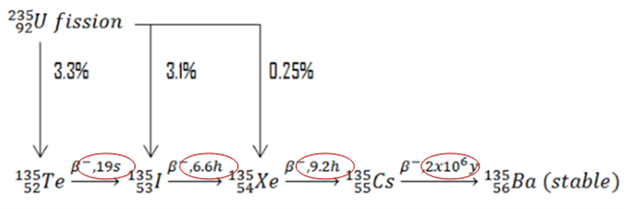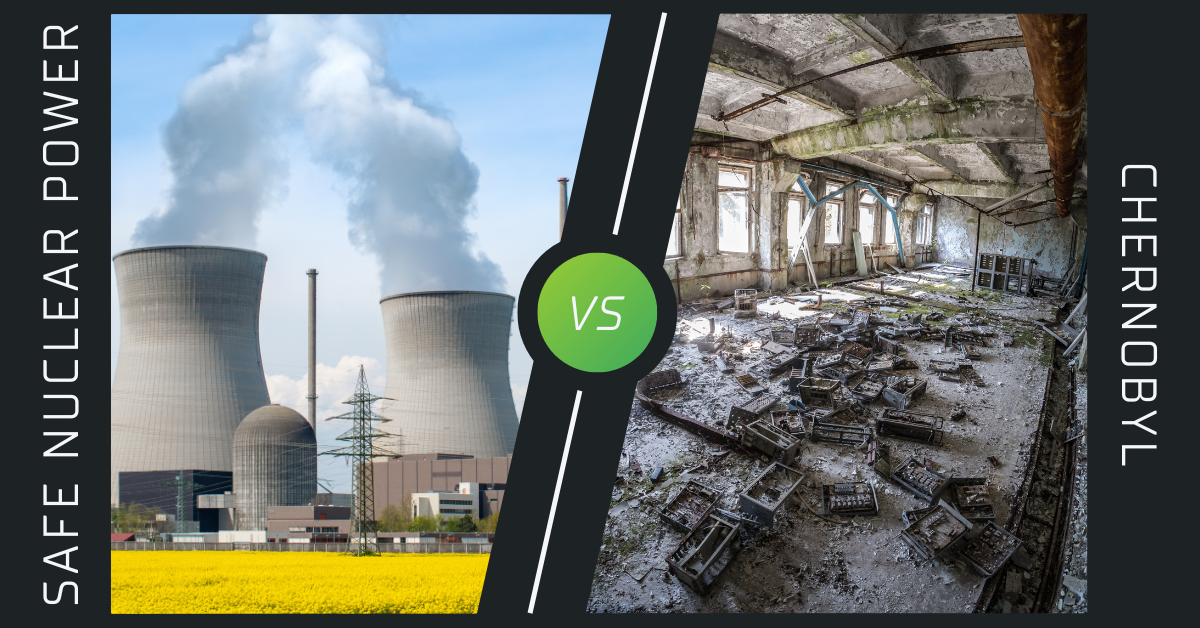
Green and climate change warriors – see how important nuclear power is to CO2 emissions in one chart, courtesy of the New York Independent System Operator (NYISO).
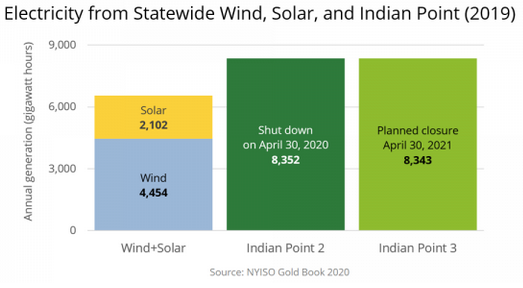 The closure of two nuclear plants wiped out more than twice the carbon-free electricity generated by all renewables in the state.
The closure of two nuclear plants wiped out more than twice the carbon-free electricity generated by all renewables in the state.
Why is nuclear power overlooked or not an option? I can think of three reasons: 1) it’s scary, and people don’t understand it; 2) it’s too expensive; 3) radioactive waste.
Accidents and Disasters
Reason #1, it’s scary, is due to prejudice and ignorance. There has only been one nuclear power plant disaster in world history. The top five nuclear “disasters” include:
- A nuclear-fuel-manufacturing accident in the USSR, circa 1957
- A weapons-grade-manufacturing facility in the UK, circa 1957
- Three Mile Island in 1979 (not a disaster)
- Fukushima’s tsunami wipeout in 2011
- The 1986 Chernobyl explosion was a disaster!
If you haven’t seen the miniseries Chernobyl on HBO, I recommend it but prepare for gruesome scenes among acts of heroism, gross negligence, and life under a communist regime. The movie and many articles about the accident talk about a “positive void coefficient.” I was schooled in the nuclear Navy and cannot recall the term.
Naval reactor plants and about 2/3 of commercial reactor plants worldwide are pressurized water reactor (PWR) plants for superior safety and less radioactive contamination compared to BWR plants. All PWR and BWR reactors in the US are water-cooled and water-moderated.
Chernobyl Design
Here is a cartoon of the Chernobyl plant design, aka an RBMK design. It deploys a water-cooled, carbon (graphite)-moderated design.
 The RBMK plant includes a water tube boiler, just like coal-fired boilers, except Chernobyl’s heat source is nuclear fission. There is only one water/steam loop. Pressurized water plants, like in the Navy and commercial fleets, have a pressurized water loop (no boiling) and a secondary loop with the boiling, power generation, and condensing cycle. The US Nuclear Regulatory Commission provides a nice cartoon of a PWR plant below.
The RBMK plant includes a water tube boiler, just like coal-fired boilers, except Chernobyl’s heat source is nuclear fission. There is only one water/steam loop. Pressurized water plants, like in the Navy and commercial fleets, have a pressurized water loop (no boiling) and a secondary loop with the boiling, power generation, and condensing cycle. The US Nuclear Regulatory Commission provides a nice cartoon of a PWR plant below.
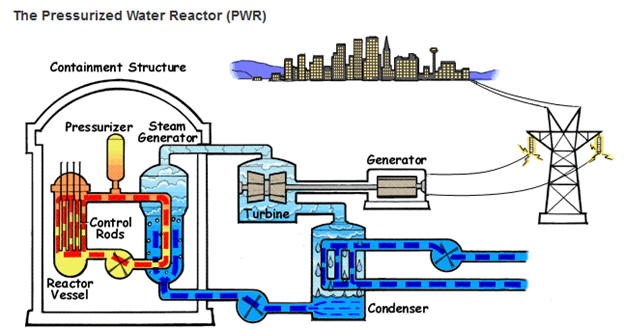 Notice the containment vessel we have in the US, compared to nothing in the Chernobyl design.
Notice the containment vessel we have in the US, compared to nothing in the Chernobyl design.
Reactor Control
Controlling the density (or amount) of thermal (low energy) neutrons is the name of the game in either design. Fuel needs to absorb thermal neutrons to become unstable and fission. Fission creates fast neutrons, heat, daughter products (atoms), and nuclear radiation. Fast neutrons are converted to slow thermal neutrons through collisions with a moderator. Water is a fine moderator, but the infamous RBMK plants at Chernobyl used carbon as a moderator.
Neutrons either leak out of the core or get absorbed by the fuel, control rods, or a burnable poison. Don’t you love these terms? The basics are shown in the cartoon below. The fast neutron collides with water or carbon atoms like billiard balls to dissipate energy. The neutron is absorbed by fuel to create another fission, and the chain reaction is sustained.
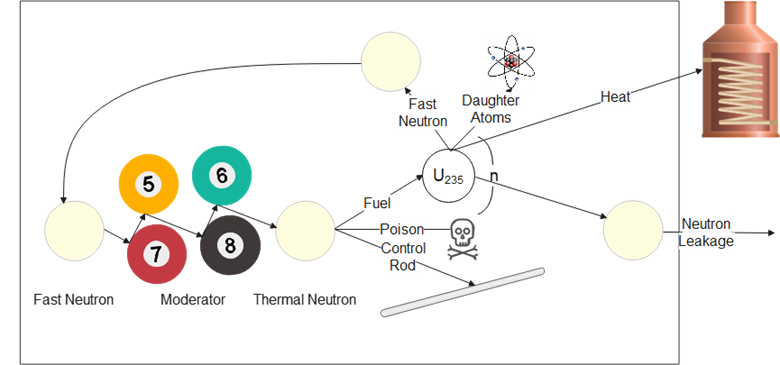
PWR Automatic Stable Feedback Control
In our pressurized water reactors, the poison “burns” (absorbs neutrons) at roughly the same rate as the fuel. The control rods rarely move. Reactor power is controlled naturally with water density. Colder water is denser, producing more collisions, resulting in more fissions, and providing more power. It’s beautiful. When the demand for steam increases, the primary water loop, shown in the orange containment structure above, gets colder to increase power automatically.
Our PWRs have a negative void coefficient. A void is produced when water changes phase from liquid to gas (steam). As described above, less water in the core means fewer thermal neutrons and less power => and stability!
RBMK Positive Void Coefficient
I had to dig for a while to figure out how a positive void coefficient could happen. You may think the internet has everything. Maybe, but it’s not chock-full of positive-void-coefficient explanations. The World Nuclear Association skates right past it in its story of the Chernobyl disaster. Wikipedia’s description is awful.
I can think of two scenarios that would cause a positive void coefficient. The first is that the coolant (water) carries boron, a neutron poison. Less water and less poison could result in higher reactivity and power. The second, per my read, is that low uranium isotope 235[1] (U235) enrichment[2] (cheap fuel) requires massive saturation of thermal neutrons to sustain a chain reaction, and water becomes a poison. I do not remember this discussion in nuke school because naval nuclear fuel is highly enriched to last the life of the ship (about 30 years). I even watched the HBO explanation a dozen times and still don’t know for sure.
Ingredients for Disaster
- Disaster ingredient number 1: The Soviets were cheap SOBs. Carbon is used as a moderator, so cheap, minimally enriched uranium could be used for fuel. Also, there was no containment vessel, etc.
- Disaster ingredient number 2: RBMK’s positive void coefficient is an unstable characteristic. More steam increases reactivity, which increases fission, which generates more steam, and so on.
- Disaster ingredient number 3: The plant operators started a risky test to disable the emergency cooling system and see if the spinning turbines could power the reactor coolant pumps for a minute while the backup diesel generators could come online. What could possibly go wrong?
- Disaster ingredient number 4: Xenon 135 or Xe135 is another strong poison that absorbs thermal neutrons. Xe135 is produced by U235 fission and through the decay of unstable Tellurium 135 and Iodine 135. The decay chain is shown below, with the half-lives[3] in increasing duration. Six and a half percent of U235 fission products result in a strong poison in the fuel assemblies, and it builds up with a 6.6-hour half-life and no neutrons to absorb when the reactor is powered down.

- Disaster ingredient number 5: They wanted to run this dangerous test with the day shift, but the grid operator said no. You will run at half-power for about 11 hours—Xe135 accumulated in the fuel assemblies. The untrained night shift ran the test as the crazy test engineer Anatoly Dyatlov barked orders. Damn the torpedoes! Force breaks things.
The Sequence
The xenon built up in the core while it ran at half-power. The test was to run at about 22% power. As they lowered the power in an attempt to reach 22%, the xenon sucked up all the thermal neutrons until the reactor was running at less than 1% power. What’ya do? Pull rods! Yes! Yes!
They pulled nearly all the rods out of the reactor to regain the 22% power. Along the way back up to 22%, the test began. The fuel heated up, generating steam and adding reactivity very rapidly, resulting in a fuel excursion.
Now, what do you do? Scram! Drive all the control rods back into the core – except the control rods have graphite “tips,” and the design required that they move slowly. It would take about 15 seconds to drive these things into the core. The added graphite (neutron moderator) at that slow speed caused a power surge to at least 10x design power. That caused fuel damage, and the rods got stuck, totally blowing to hell at 100x design power – enough to blow the 1,000 ton “lid” off the reactor. The core exploded through the roof and scattered deadly fuel, burning carbon, and plant structures around the site. Debate remains whether the second explosion was due to hydrogen dissociation and a resultant explosion or whether the fuel achieved prompt supercriticality and exploded like a bomb.
Conclusions
The events leading to the Chernobyl explosion were not unlike the events that caused the dominos to fall in Texas in February 2021: emphasis on low first cost, insufficient training, and lack of integrative, critical thinking. There is plenty of shared blame to go around. Add belligerence, denial, covering “the spread of disinformation,” lack of communication, and a shroud of communism, and it gets very deadly.
Wrap-up coming next week.
[1] Remember from chemistry that the number of protons, the atomic number, defines the element. The molecular weight (235, 238, etc.) is determined by the number of neutrons in the atomic nucleus.
[2] Natural uranium is 99.3% non-fissile U238 and about 0.7% fissile U235.
[3] Time required for half the atoms to decay to the next step.

